Introduction
Corsets have a long and amazing history. They have survived historical moments to the current time. Over time, they have continuously been modified to shape the bodies of women into what the society expects them to appear like. During the Victorian era, corsets were not only body shapers, but also indicators of a woman’s class and her moral standing.
This article describes Victorian corsets, and compares and contrasts them with today’s corsets. It will examine the materials used to make corsets in the two cases, and how and why they were and are worn.
Description of Corsets
Shape

Narrowest Victorian corsets took after the shape of a hourglass. They were narrowest at the middle with the upper and lower ends opening up to accommodate the bust and the hip area respectively. They did not have any strips hanging from either ends. There was a strap at the back running from the top to the bottom through small holes on both sides; this strap was used to tighten it to the body.
The front middle lower end extended by few inches downwards below the waistline. The front middle upper end extended to accommodate breast halfway in a manner today referred to as over-bust.
Modern corsets in some few ways take after the shape of Victorian corsets. One difference is seen in the middle part which is not as narrow as that of Victorian corsets. Unlike the Victorian corsets which can be said to have been significantly over-bust, today’s corsets are customized and come in the forms of over-bust and under-bust.
Materials
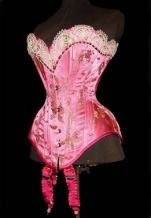
Silk corset Victorian corsets were made up of a variety of materials. Heavy linen, cotton and sometimes soft leather were popular materials (Winter 1). Colored silk was used to make corsets for special events such as weddings (Pinterest 1). Reinforcement to the corsets was by means of whale bone (Winter 1).
According to Eleri, the whale bone referred to here is not actually a bone at all but “keratinous material found around the upper jaws of baleen whales, used to filter plankton and krill” (Eleri 1). The whale bone was popular because it is flexible and very strong. Furthermore, it can be cut into very narrow strips without compromising strength. The whale bone strips were inserted into corsets to give them strength (Eleri 1; Winter 1).
Winter also noted that some plants with very strong fibers were also used to offer reinforcement to corsets. This was expected because whale bones probably could be rare at times. Steel was another strengthening material used at this time.
Iron maidens were also popular especially in the late Victorian era. Winter described iron maidens as “molded iron devices shaped like a woman’s body or in a manner anticipated to shape the body” (1). Corsets made out of iron maidens were particularly very stiff (Winter 1).
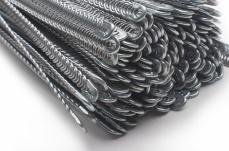
Spiral Steel Modern day corset significantly make use of fabrics such as cotton, silk and leather. The reinforcement or boning materials are numerous with the most common ones being white steel, spiral steel, plastic, and reeds. Modern technology has enabled today’s corsetieres to use light and flexible boning materials (Corset Making 1).
Convenience
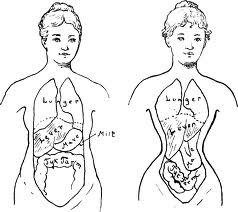
The Victorian corsets were heavy and posed a lot of discomfort due to the weight of the reinforcement materials used to strengthen them. Though they were considered flexible then, the reinforcement materials were really not very flexible. Winter noted that working women and servants could not wear corsets because they inhibited their flexibility in regard to mobility (Winter 1).
The shape they aspired to create in women meant that they had to be very narrow at the middle. Taking into consideration the anatomy of a human being, this meant that the lungs and diaphragm were put under some form of pressure. Magnifying this unfortunate state was the fact that the corset had to be tied very tightly.
Doctors of the time strongly spoke against corsets, and as if to support the doctors’ claims women in corsets often fainted. In some cases, whale bones could break and pierce the body of the wearer (Winter 1). Victorian corsets were not comfort to wear, but all the same they were always worn.
Corsets today are very convenient to wear. They are light and flexible, and are not as tight as the Victorian ones were. Today’s corsets are customized to conveniently fit into different shapes of women’s bodies. This makes it possible for a woman to go for the most convenient corset for her body (Lingerie Addict 1).
How and Why Corsets were/are Worn
Why they were/are Worn
A corset formed part of a daily attire that a woman was supposed to wear during the Victorian era. It did not matter where one resided, a corset had to be on. This piece of clothe had a huge influence in the life of a women and its significance was more than that of any other normal clothe.
Corsets were used to shape women bodies and equally significant they shaped their lives. It is argued that the sociological aspects of womanhood during the Victorian era gave corsets great significance. According to Winter, “tightly laced corsets and close-fitted clothing created the difference….it enabled the wearer to produce a form-fitted, moral, and fashionable appearance, indicating good breeding” (1).
Therefore, corsets were worn has a means of showing that one is brought up well and well behaved. This helped women from the upper class in a society to maintain their honor. They were also significant for women from poor families looking for marriage partners – wearing a corset was a show of one who is well cultured and therefore intuitively one who could become a good wife.
The Victorian era demanded high morals and women wearing corset was a significant way of showing that. Women associated with loose clothes were connected with loose morals and servants. The servants could not work well with corsets on as they could restrict their mobility while working (Winter 1).
Another reason why corsets were worn was to create a shape which was considered feminine. Victorian corsets are said to have been very narrow just above the waistline. The shape that women aspired at this time was that of a hourglass or a wasp.
It is surprising that even young girls had their versions of corsets. It was important that they also showed their class in the society. Therefore, girls grew up knowing that corsets formed part of female clothing (Winter 1).
In general, wearing a corset in the Victorian era was more of a mandatory societal expectation of a woman of moral standards and upper class. It was also used to shape their bodies into the expected hourglass-like feminine shape (Winter 1).
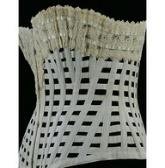
As the popularity of corsets grew, they were made to fit different activities. For instance, there were corsets for swimming, bicycling among other sport activities. The image shown here belonged to that of a corset called a ventilated corset. It was worn by women who engaged in sports activities and was also popular during summer (Pinterest 1).
It is surprising that there were corsets for men though their prevalence was quite low. The men corsets were made to offer support to the abdomen. There were also corsets made for pregnant women styled to support the growing abdomen (Winter 1). This was simply an era corsets ruled.
Modern day corsets are mostly worn for purpose of beauty unlike Victorian corsets which were worn for many reasons. There is a difference in the prevalence of corsets during the Victorian era and today. Today’s corsets do not carry even a quarter of the significance they had during the Victorian time. They do not enjoy the popularity and prestige that their counterparts enjoyed during the Victorian time. However, this is not to say that they are useless today.
Majority of women today do not wear corsets and even for those who do they do not wear them on a daily basis. They are significantly worn selectively and by only women. It is rare to find children corsets. This is in contrast to the Victoria era whereby young girls and even men wore corsets.
However, corsets are still playing the role of shaping the woman body as they did during the Victorian time. In addition, corsets are also used in fashion shows (Lingerie Addict 1).
How they/are were worn
Having examined the question on why corsets were/are worn, it is time to examine how they were worn. The wearing of Victorian corsets has been marred with controversies. It is known that they were worn under a dress (Winter 1). But how tightly they were tied has been a subject of speculation. Nevertheless, as the diagrams below show, it is suspected that they were tightened very strongly.
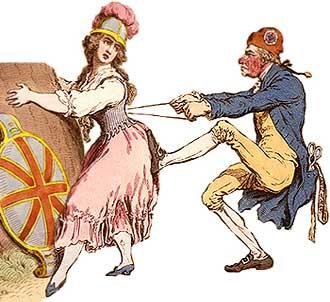
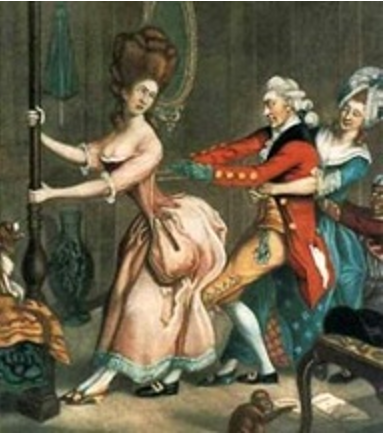
(Fashion 1)
It is said that the corsets were so tight that many times women fainted as a result of being unable to breathe well.
The impression created by different authors writing on Victorian corsets is that a woman had to get some assistance to wear a corset (Winter 1; Eleri 1; Pinterest 1; Fashion 1). This was probably because of significance that the hourglass-shaped body carried. This shape was significant and a tight corset also spoke volumes about the integrity and morals of the wearer. Integrity and right morals ruled the Victorian era.
This is contrast to today whereby corsets are less tight and there is no societal pressure to make them tighter. Unlike Victorian corsets which were worn as undergarments, modern day corsets are made in a manner that they do not have to be worn as undergarments.
Conclusion
Corsets formed a very intimate part of the lifestyle of a woman in the Victorian era. Corsets were worn to help shape the body and were also a show that one is well behaved and not loose. The society expected women to wear their corsets and as a result corsets were very common and popular in the Victorian era. Today, corsets are not very common though they are popular.
There is also no societal expectation for women to wear corsets. Boning materials used in reinforcing Victorian corsets were steel, iron maidens, or whale bones. These materials made Victorian corset quite heavy. Today’s corsets are reinforced with light materials which include steel, spiral steel, plastic and reeds. As a result, they are light and convenient to wear.
Works Cited
Corset Making. Boning. Corset Making Supplies, 2013. Web.
Eleri, Lynn. Well-Rounded: A history of corsetry, from whalebone to Lycra. Slate, 2010. Web.
Fashion. How to Lace a Corset. Fashion, 2013. Web.
Lingerie Addict. Corsets: shapes, silhouettes, and fabrics. The Lingerie Addict, 2013. Web.
Pinterest. Steel Embrace: Antique Corset Love. Pinterest, 2013. Web.
Winter, Denise. Cinching Up in the Victorian Era – Corsets! Denise Nadine Design, 2005. Web.